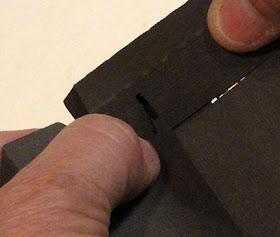Create this tray to use with the Quilt Blocks paper boxes for puzzle pattern play.
Here are the main pieces. Cut from heavy weight cardstock for durability. The large squares is the slotted base. Match each "wall" piece with its symbol to the corresponding side edges of the base square.
The single symbol cutout sides are assembled first.
1. Fold short tabs back toward backside of cardstock. Fold long opposite tab toward backside. Fold along long perforation rows. Repeat for each of four "wall" pieces.
2. Work from front side of base. Insert tabs of one side piece into slots.
 3. Turn assembly over to work from backside. Pull tabs through fully and lay flat next to base square edges. Tabs should be folding toward outside edges of square. Apply adhesive to tabs backside surface. Press to attach and glue securely.
3. Turn assembly over to work from backside. Pull tabs through fully and lay flat next to base square edges. Tabs should be folding toward outside edges of square. Apply adhesive to tabs backside surface. Press to attach and glue securely.
 4. From front side, fold wall piece perpendicular to base front, then fold at each perforation row so that long tab perforations align parallel to base square cut edge.
4. From front side, fold wall piece perpendicular to base front, then fold at each perforation row so that long tab perforations align parallel to base square cut edge.
 5. Apply adhesive to long tab back side. Position long tab so that back square cut edge fits snugly along wall perforation. Apply pressure all along edge by pressing top and bottom surfaces of wall to secure.
5. Apply adhesive to long tab back side. Position long tab so that back square cut edge fits snugly along wall perforation. Apply pressure all along edge by pressing top and bottom surfaces of wall to secure.
Use a thick book or equivalent object to provide an edge to apply pressure near the targeted edge being glued.
Repeat for the opposite side (single symbol).
6. Next prepare the final two side walls by folding the INSIDE end tab piece toward the front side as shown.
7. Insert short tabs into slots, turn to assembly over, then glue as for first pair of sides as shown in Step 3. (However, this time the wall piece cannot be laid flat.)
8. Unfold and insert INNER end tab into adjacent slot on previously joined wall piece.
9. Apply glue face of tab then apply pressure to attache tab to inside of wall. Use a pencil inserted into wall cavity to apply pressure. Make sure that the two walls being "joined" by tab are snuggly touching at the corner.
10. Fold back end tabs on first walls.
 Apply glue to two placed on wall that is already in place: A) corner top surface . .
Apply glue to two placed on wall that is already in place: A) corner top surface . .
 and B) outside corner tab.
and B) outside corner tab.
11. Fold wall around to backside and hold corners to square up snuggly and allow glue to secure. Repeat for all four corners.
12. Apply glue to long tab of wall, position perforation snuggly to base square edge as before (Step 5).
Also apply even pressure along edge by pressing top and bottom of wall surface and moving fingers as glue cures.
Repeat for final wall.
13. Apply adhesive evenly across backing square back side. Position on back of assembled tray and work pressure across evenly.
Now your Quilt Block Puzzle tray
is ready to use with sixteen cardstock blocks
and decorative patchwork shapes.
Find a tutorial to assemble the boxes on this blogspot.
 Create this set of 3d puzzle blocks to provide hours of pattern play. This tutorial is for the box that builds the pattern. A tutorial for the blocks tray can also be found on this blog.
Create this set of 3d puzzle blocks to provide hours of pattern play. This tutorial is for the box that builds the pattern. A tutorial for the blocks tray can also be found on this blog.















































